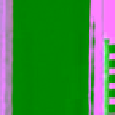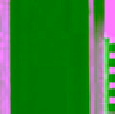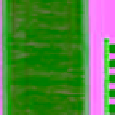Geoscience Reference
In-Depth Information
Table 1.
Muddy lithofacies; their characteristics and inferred depositional processes. The mudstones are given genetic names
to ease the cross-reference and readability of the text. Numbers in coloured boxes in left column refer to lithofacies coding in
Fig. 6. The width of individual core slabs is 10 centimetres.
Characteristics
BI & Diversity
Microfacies
Index
Core
Appearance
Depositional
Architecture
Shale T
ype
Lithology
Pelagic
Dark to dark grey,
rarely dark
greenish grey
claystones
High BI
Medium to Low
Diversity
High
Extensive blankets
1
Hemi-pelagic
Greyish and
greenish grey
claystones and
mudstones
Medium to High BI
Medium to High
Diversity
Medium
to High
Fairly extensive
blankets
Contouritic
Green to grey
mudstones
and siltstones,
sometimes ripple
cross-laminated
Low to medium BI
Medium to High
Diversity
Low to
Medium
Lobate blankets to
patchy (erosional
remnants)
2
Turbiditic
Grey and dark
grey mudstones
and siltstones,
laminated
Low BI
Low Diversity
Low
Lobate blankets
The channel-belt association consists of ero-
sively based, commonly amalgamated bedsets
(Table 3; Figs 8A and 9) of stratified and cross-strat-
ified sandstones, ripple cross-laminated sandstone
lags, granule sandstones and shale-clast conglom-
erates, as well as interbedded turbiditic and rare
hemipelagic mudstones (see Tables 1 and 2 for
interpretations of lithofacies). Locally, also,
deformed and slumped strata are present. The bed-
sets normally form fining-upwards, or more rarely
coarsening-to-fining upwards motifs. These are,
based on the component facies, the mixture of
coarse and heterolithic lithologies, as well as the
vertical facies successions, interpreted to represent
submarine channel-fills (Clark & Pickering, 1996).
Such channel-fill motifs are common from sandy
submarine fan systems in a variety of settings
(Gardner & Borer, 2000; Gardner
et al
., 2003;
Grecula
et al
., 2003a; Milli
et al
., 2007; O'Byrne
et al
., 2007; Sweet
et al
., 2007), with individual
motifs representing single-storey channel-fills.
Basal boundary surface was probably concave
upwards and erosional, as inferred from borehole
dip-meter data. The common amalgamated character
of these compound motifs suggests that they
represent channel complexes (or storey sets; e.g.
Eschard
et al
., 2003; Grecula
et al
., 2003a; Euzen
et al
., 2007) at the outlet of slope tributary systems
(e.g. Johnson
et al
., 2001; Decker
et al
., 2004;
Gervais
et al
., 2004, 2006; Hodgson
et al
., 2007;
Deptuck
et al
., 2008). Channel sinuosity (as inferred
from seismic data) is low (less than 1.2; e.g. see
Figs 10 and 11).
The channel-to-lobe transition/braided fan asso-
ciation comprises amalgamated and scoured bed-
sets (Table 3; Figs 8B and 9) of stratified and
cross-stratified sandstones, as well as rare shale-
clast conglomerates. The bedsets are embedded in
hemipelagic and/or contouritic mudstones, range
from a few to more than nine metres-thick and
define simple thinning-upward and fining-upward
motifs or more complex thickening-upwards and
coarsening-upwards to thinning-upwards and fin-
ing-upwards motifs. Interbedded claystones are
relatively uncommon. Erosive surfaces was again
concave upwards, although dipmeter data suggests
a more gentler relief compared to the boundary
surfaces of the proper channel storey fills (see


















Search WWH ::

Custom Search